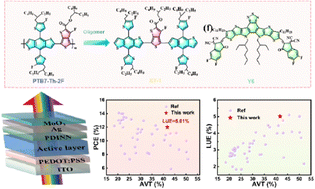Despite the high significance of active layers with all-narrow band gap (all-NBG) materials for developing semi-transparent organic solar cells (ST-OSCs), the low power conversion efficiency (PCE) is the key limitation for their practical applications. Herein, a new oligomer XY-1 of the PTB7-Th-2F host polymer donor is introduced for the first time as a guest component into the PTB7-Th-2F:Y6-based all-NBG system to improve the performance of ST-OSCs. The oligomer naturally alloys with the host donor to promote the polymer crystallization and stabilize the film morphology. More intriguingly, oligomer XY-1 plays a multiple-function role in regulating energy levels and light transmission, well-balancing the film-forming process of the donor and acceptor and optimizing the charge dynamics. Ultimately, the PCE of the PTB7-Th-2F:Y6-based opaque bulk heterojunction (BHJ) device is significantly improved from 12.72% to 14.49%, representing the highest efficiency of the PTB7-Th-family BHJ devices. The corresponding ST-OSC achieves an impressive PCE of 12.00% with high average visible transmittance (AVT) of 41.76%, delivering an exceptional light utilization efficiency of 5.01%, which is the best value of PTB7-Th-family BHJ devices and ranks among the top values of ST-OSCs. The ST-OSC also exhibits superior photo-thermal stability, and thermal insulation, highlighting the significant potential of oligomers in developing high performance ST-OSCs for multifunctional applications.
